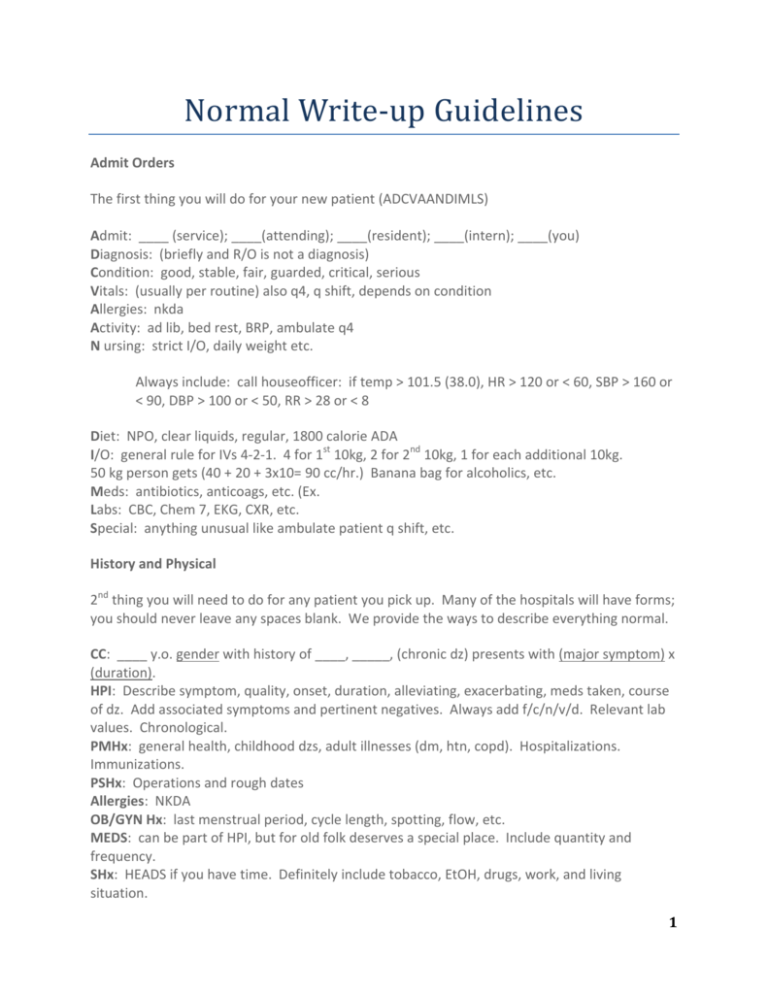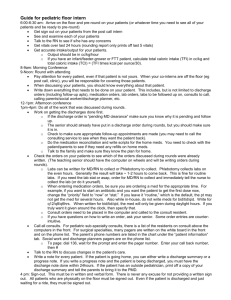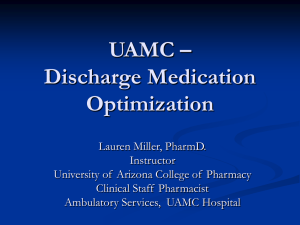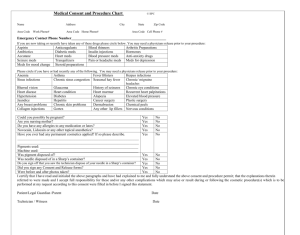Normal Write‐up Guidelines
advertisement

Normal Write‐up Guidelines Admit Orders The first thing you will do for your new patient (ADCVAANDIMLS) Admit: ____ (service); ____(attending); ____(resident); ____(intern); ____(you) Diagnosis: (briefly and R/O is not a diagnosis) Condition: good, stable, fair, guarded, critical, serious Vitals: (usually per routine) also q4, q shift, depends on condition Allergies: nkda Activity: ad lib, bed rest, BRP, ambulate q4 N ursing: strict I/O, daily weight etc. Always include: call houseofficer: if temp > 101.5 (38.0), HR > 120 or < 60, SBP > 160 or < 90, DBP > 100 or < 50, RR > 28 or < 8 Diet: NPO, clear liquids, regular, 1800 calorie ADA I/O: general rule for IVs 4‐2‐1. 4 for 1st 10kg, 2 for 2nd 10kg, 1 for each additional 10kg. 50 kg person gets (40 + 20 + 3x10= 90 cc/hr.) Banana bag for alcoholics, etc. Meds: antibiotics, anticoags, etc. (Ex. Labs: CBC, Chem 7, EKG, CXR, etc. Special: anything unusual like ambulate patient q shift, etc. History and Physical 2nd thing you will need to do for any patient you pick up. Many of the hospitals will have forms; you should never leave any spaces blank. We provide the ways to describe everything normal. CC: ____ y.o. gender with history of ____, _____, (chronic dz) presents with (major symptom) x (duration). HPI: Describe symptom, quality, onset, duration, alleviating, exacerbating, meds taken, course of dz. Add associated symptoms and pertinent negatives. Always add f/c/n/v/d. Relevant lab values. Chronological. PMHx: general health, childhood dzs, adult illnesses (dm, htn, copd). Hospitalizations. Immunizations. PSHx: Operations and rough dates Allergies: NKDA OB/GYN Hx: last menstrual period, cycle length, spotting, flow, etc. MEDS: can be part of HPI, but for old folk deserves a special place. Include quantity and frequency. SHx: HEADS if you have time. Definitely include tobacco, EtOH, drugs, work, and living situation. 1 FHx: Health and cause of death of parents and grandparents. Siblings. CAD, HTN, HL, DM, etc. ROS: *most times just write denies.... (don’t have to do all) Gen: usual weight/ recent change. Weakness, fatigue, fever, chills Skin: rashes, bump, sores, itching dryness Head: headache, dizziness, vertigo Eyes: vision, diplopia, pain, redness, glaucoma, cataracts Ears: hearing, tinnitus, aches, discharge Nose: stuffiness, discharge, epistaxis, sinus pain Throat: sore throat, hoarseness, dysphagia, bleeding gums Neck: stiffness, pain, masses Breasts: lumps, tenderness, nipple discharge, gynecomastia Lungs: SOB, cough, sputum, hemoptysis, pleuritic pain, wheezes CV: chest pain, radiation, palpitations, blocks can walk, orthopnea (# of pillows), orthostasis GI: pain, appetite, heartburn, vomiting, stools (diarrhea, color, caliber, blood, constipation) GU: frequency, urgency, hesitancy, retention, caliber, nocturia, pain, blood, incontinence Male repro: libido, erection, discharge, sores, infertility Female repro: libido, discharge, itching, menarche, menses (regularity, frequency, duration, flow, spotting), menopause, #pregnancies, deliveries, abortions, stillbirths, birth control Musculoskeletal: pain, swelling, redness, arthritis, gout, backache, weakness, cramps Neuro: convulsion, tremor, paralysis, incoordination, pain, syncope, vertigo Physical Exam Vitals: (always the first part) General: WDWN, NAD (obese, wasted, chachetic, sob, etc.) A + O x 4. Skin: Unremarkable (include size, location, symmetry, description of lesions) HEENT: NCAT Eyes: PERRLA, EOMI, conjunctiva clear, anicteric Ears: tympanic membranes clear, visible light reflex, no erythema, no discharge, no effusion Nose: no erythema, no discharge, nares patent Throat: oropharynx clear, no erythema, no exudate, moist mucous membranes, tonsils present Neck: supple, no LAD, no JVD, no masses Chest: CTA b, no rales, ronchi, wheezes CV: RRR no m/r/g Abd: non‐tender, non‐distended (NT/ND), + bs, no masses, no HSM GU: (always examine) neg lesions, neg hernia, no masses, no LAD Rectum: (always) good sphincter tone, no hemorrhoids, no masses, prostate normal no masses, guaiac neg. Ext: 2+ peripheral pulses bilaterally, no pedal edema, no C/C/E Neuro: + O x4, 2 + DTRs, downgoing Babinski, neg. Romberg, good finger to nose, 5/5 motor Sensory intact, gait, tone, muscle bulk. CN II‐XII grossly intact. Labs and Studies 2 Assessment and Plan: Problem based. The most important part of H & P. Problem 1: (example chest pain, always the presenting problem) 1. Most likely caused by …. (and why) 2. Differential 3. Plan (both work‐up and treatment) Problem 2: (other problems noted on physical exam, labs, studies) Progress Notes You will do one every day. These are relatively brief in SOAP format. Focus on the problem. (Title) Date/ Time MS III Progress Note S: HD # ____ for ____ y.o. M/F with hx of ___, ____, admitted for ____(current diagnosis). Overnight... Describe how patient feels, slept. Include last bowel movement (caliber, blood, etc.), urination Denies f/c/n/v/d Meds: always include current meds, recent d/c meds, or changes O: Vitals: Tm @, Tc, BP, P, R, Sat, I/O + minimal physical exam, focus on relevant parts for dz Gen: WDWN, NAD HEENT: moist mucous membranes Neck: supple, ‐ lad, ‐ jvd Lungs: CTA b, no rales, ronchi, wheezes CV: RRR no m/r/g Abd: NTND, + bs, no HSM Ext: neg. C/C/E (cyanosis, clubbing, edema) Labs: can write pending, but then have to include addendum later. Always good to include results from imaging studies. For extra brownie points, summarize notes and recommendations from consults A/P: good to do by system, especially in internal medicine Neuro: state problem — then your plan CV: stable, no issues (good to write when nothing going on) Pulm, GI, GU, FEN, ID, Heme/onc (include these also) Discharge Orders Discharge to home Condition: Activity: as tolerated, ad lib, physical therapy 3 Lines: d/c (include all current lines) Diet: regular (low cholesterol, ada 1800, low salt etc.) Meds: (probably longest include all meds going home on, glucose strips, etc.) F/U: usually write in one with PCP Special instructions: if unusual. Presentations Three types, there is a certain elitism in memorizing, try not to read them word for word. Formal: pretty much your h & p. Your goal is to convince your audience, so that your assessment should not surprise anyone. Although a well‐organized h & p is important, in the end having a sound assessment and plan is most important. Good to have a differential with good reasons why some are stronger than others. SOAP: These are for daily rounds, to catch up resident/attending with patient, again A/P is important. Pretty much presenting your SOAP note. Bullet: This is a one sentence to familiarize patient: “HD #, hx of, diagnosis, current condition, what is being done”. Orders You will always impress interns by having the orders already written out so all they have to do is sign them, of course this implies you have a clue what to do, which can always be a mystery. Everything that needs to be done needs to be written in orders. Common order: M Labs: CBC, chem 7 Abx: 4 things always to be included: name, quantity, mode of entry, frequency Lisinopril 10 mg PO qd 4







